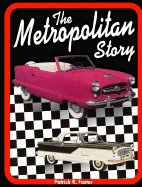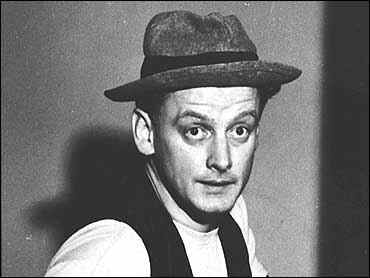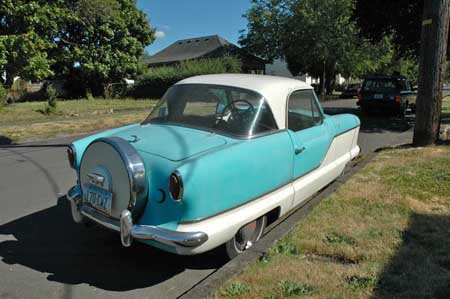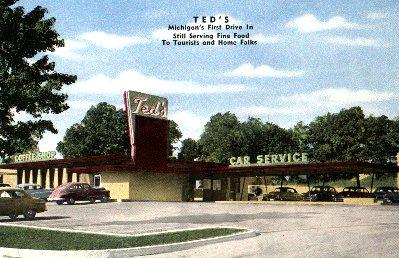
I am going to write about the beloved Nash Metropolitan this morning. It is, I think, a non-controversial topic on which to write. I was thinking about it in the course of marveling at the news that we are going to spend abut $67,000 a year on undocumented Dreamers, of whom we understand we will be hosting 125,000 by the end of this year.
A Metropolitan then had a price-point of about $1,500 bucks. It is tempting to say that we could give those children sixteen years or above forty new cars to drive back home, but of course in constant dollars, the appropriate way to calculate relative worth across the years, it is only about three new compact cars.
But never mind. I used to hear that the war in SE Asia cost enough to buy are the Vietnamese a new Ford Mustang, so I guess it is something to keep in mind. This is supposed to be non-controversial, so let’s drive on.
Patrick Foster, a tireless chronicler of the American Motors marque, did a nice book on the subject, “The Metropolitan Story.” My father Raven was a source for much of the material, having been the assistant head of Design for the American Motors consortium in the time. They became great pals, and I strongly urge you to check out Patrick’s many books and articles if you have an interest.
I remember vividly an early Metropolitan story- we owned one, of course, and that was just after the time that Dad taught Mom how to drive.

It is funny to look back more than a half century to times that that- sort of like watching the gray-white kinescope record of Jackie Gleason’s The Honeymooners, when he and New York Sanitation Worker buddy Ed Norton worried about things like whether they could afford a telephone land line.
Seriously. That is how much and how fast that old world has faded away. I noticed the discontinuity years ago- that people on public assistance today have so much more in creature comforts than the generation that grew up in the New Deal, fought the Good War, and came back to an America that was roaring with energy.
To get telephones and deal with a magical new world filled with challenge, opportunity and the Red Menace.
I remember some of that stuff, but nothing as vivid as Raven producing a coping saw one afternoon and announcing that day in 1957 that he was going to put a trunk in the Metropolitan.
OK- a quick step back. The Metro was the first little car on the modern American road. It was the brainchild of George Mason, the automobile one, who decided to buck the Detroit iron trend of “lower, longer, bigger faster” and produce what was envisioned as something else pretty new: a second car for the American Family. It was one of the first cars produced with an eye to the women’s market- another quite new thing.
You know, a car for Mom to take the kids to school or run errands in the increasing suburban sprawl. Anyway, there was a project car called the Nash Experimental International- the NXI- which was renamed on introduction to be the Metropolitan to better evoke the concept.
The reality was quite different. This was a contract deal with the Austin Motor Company in Britain (among others) and would be the first motor car intended for the North American Market to be built entirely in Europe.
On it’s introduction, the little car was intended to be a miniature version of the big Hudson and Rambler six-passenger sedans. Mechanix Illustrated’s automotive editor Tom McCahill (the Illustrated was always around Dad’s workshop each month as a source for projects) said “It is not a sports car by the weirdest torturing of the imagination but it is a fleet, sporty little bucket which should prove just what the doctor ordered for a second car, to be used either for a trip to the movies or for a fast run to a penicillin festival.”
I have no idea what he meant by the last, but he added that it was a “nice-handling car with plenty of control and amazing dig, considering it is powered by a small Austin A-40 engine.” He reported that his test car accelerated from zero-to-sixty in a bit under 20 seconds, and topped out at slightly over seventy miles an hour.
His biggest gripe was that although the finish was “very nice,” having no trunk opening was a problem. In typical quirky British fashion, the only way to get to the storage in the “boot” was by pulling the front seat forward, leaning into the back seat area (charitably termed tiny) and pulling down the back of the rear seat. He was not alone. Motor Trend said the rear “utility” seat was “a joke.”
I think ours was a 1956 or earlier. The color was about what you see here:

The trunk you see was the project of the weekend for Dad. With the 4th generation Metros coming along, they fixed the trunk access problem and the replacement hardware was available through the Company garage, and he decided to do the job himself. So, out with the saw and off came the back deck.
Attaching the hardware and doing the finish work was going to take some additional time, so he decided to take the family for a drive while we had a rumble seat. The grown up were in the front seats and the three kids jumped in the trunk. Dad decided on a drive out to country and a special treat: a stop at Ted’s Drive In at the intersection of Maple Street and US-24, the Telegraph Road.
Dining out was not something we did a lot, so this was a huge treat, not the least of which was poking our head’s out of the cute little car and waving at people as we whizzed by.
Ted’s was Michigan’s first drive-in was located near Square Lake Road in Bloomfield Hills. The original was a lunch wagon near the Peace Bridge in Buffalo, the same town that gave us the Beef-on-Weck sandwich that Tracy O’Grady now brings us on the last Friday of the month at the Willow restaurant.
The one we knew in Michigan opened in 1954 on US-24 and was known as the home of “the worlds largest char broiled hot dog,” Their fries were to die for- or at least they were in the opinion of this eight year old, and the little plastic tubs of catsup were quite unlike anything that came out of a bottle of Heinz 57 in Mom’s refrigerator.

We had a nice afternoon lunch- inside, as I recall, and then motored back to Grabbingham with the wind in our hair. Mom was going to finally be able to get the groceries out of the trunk while still maintaining control on her unruly brood.
Eventually we replaced the Metro with a Rambler American- a much more functional car for the kids much larger kids. It is another one I wish we had kept. I wish Ted’s were still there for a pit-stop on the way into the old home town from the interstate. But it is gone now, though apparently some locations remain in Buffalo and Arizona, for some reason.
They tore the place down, but the intersection was still a hot spot for fine dining. In fact, the Machus Red Fox at 6676 Telegraph Road was one of the restaurants that replaced it as a destination. A little more upscale, of course, which is why Jimmie Hoffa, former President of the Teamster’s International Union went there to meet with some associates in the afternoon of July 30th, 1975.
It would have been Jimmy’s last trip to any sort of restaurant, and they have been looking for him, ever since. But of course, that is a different story. Same place. Different story, but it does involve cars.
Copyright 2014 Vic Socotra
www.vicsocotra.com
Twitter: @jayare303
